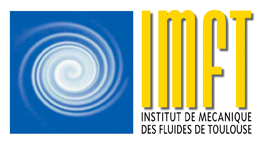Modélisation, simulation et étude expérimentale de l’ébullition dans le processus de trempe thermique.
Soutenance de thèse Gauthier Bourdon
Mercredi 23 octobre à 14h00 – Amphithéâtre Nougaro
Abstract
Quenching a steel piece is performed during the production process to improve its mechanical strength. This thermal process involves heating the part to a high temperature and then immersing it in a low- temperature coolant, which then might boils. The steel cooling rate determines its microstructure and mechanical properties. Controlling this heat treatment is crucial for steel pieces used in the primary circuit of a nuclear power plant. This thesis proposes a numerical and experimental study of the boiling phenomena generated in the quenching process. The main objective is to develop a realistic simulation model of the quenching process for piece sizes typical of the nuclear industry. The first part of the study focuses on film boiling around an immersed solid based on direct numerical simulations (DNS) (disk and sphere). Implementations have been made in the DIVA code to couple different models for simulating boiling, including immersed boundaries, and vapor density variability. These couplings were validated by comparison with analytical correlations or experimental results. Convergence in time and space has also been investigated. Finally, a parametric study of film boiling around a highly superheated sphere immersed in a subcooled liquid was carried out. This led to a better understanding of the phase-change mass flux distribution and the angular distribution of the Nusselt number. Secondly, an initial experimental study was carried out on the quenching of SS304L stainless steel at different subcooling temperatures. Quenching is performed on both ends of a horizontally positioned cylinder. The side face is thermally insulated. The cylinder was first heated and then cooled in air to create a thick oxide layer on the surface. Quenching is then carried out in water. Analysis of the temperature
readings shows a strong dependence of cooling on subcooling. However, there appears to be a threshold at which increasing subcooling no longer accelerates the cooling of the steel piece to the same extent. The repeatability of the experiments is also satisfactory for all three tests. These data can be used to validate calculation codes. Although the experiment was initially designed to measure the heat flux during quenching, it eventually became apparent that the experimental setup did not allow for a correct estimation of this flux due to measurement biases. The effect of these biases has been quantified for a simplified configuration. The more rapid the cooling, the greater the bias. A second quenching experiment was carried out on a semi-industrial SS304L steel cylinder, positioned vertically. Instrumentation with thermocouples for this large piece, as well as its handling, posed technical difficulties that reduced the experiment to a single trial. The measurements obtained will be used to enrich databases for validating calculation codes. In parallel, a digital twin has been developed with the CFD code STAR-CCM+. It uses correlations from the literature to model heat exchange between the solid and the fluid. Two-phase fluid flow is considered using a volume of fluid (VOF) model, combined with URANS k − ε realizable turbulence modeling. The results of simulations involving the entire experimental set-up are in good agreement with the experimental data. Cooling is very well predicted for the bottom of the cylinder, but the model predicts faster cooling for the middle and top of the cylinder.
- Direction: Christophe Airiau et Sébastien Tanguy
- Rapporteur : Adrien Toutant et Didier Saury
- Examinateurs: Catherine Colin et Giovanni Ghigliotti
- Invités : Thomas Sageaux et Alejandro Carlos Mourgues-Codern, Framatome.
